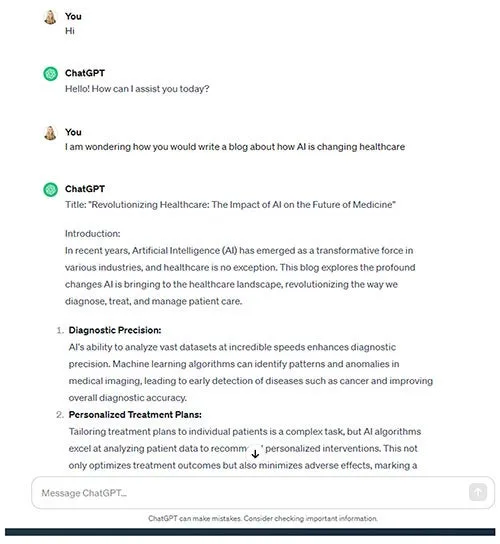The Future Is Here: Embrace AI or Risk Falling Behind

In recent years, Artificial Intelligence (AI) has emerged as a transformative force in various industries, and healthcare is no exception. This blog explores the profound changes AI is bringing to the healthcare landscape, revolutionizing the way we diagnose, treat, and manage patient care.
Are you excited to read more?
As much as I would like to take credit for the above, ChatGPT wrote it along with a full blog post in a few seconds.

The AI revolution is happening faster than regulation and faster than education can keep up with. With this push to integrate AI into almost every industry, including healthcare, there is an overwhelming sense that we must all get on board or be left behind.
Throughout the past year’s medical conferences, AI has been a recurring theme during the various presentations and the sentiment was clear: AI is here to stay and we should all get comfortable using it in our everyday lives. Though many cautioned that as AI becomes increasingly ingrained in healthcare and other professional industries, ethical questions arise. Concerns regarding privacy, data security, and the responsible utilization of AI technologies require cautious considerations. It is essential to strike a delicate balance between fostering innovation and upholding ethical and data safety practices for the seamless integration of AI into everyday operations.
We are already seeing AI leveraged for infection prevention and control in hospitals in various ways, including:
- Automated Monitoring of Hand Hygiene Compliance
- Predictive Analytics for Patient Admissions
- Environmental Monitoring (air quality, temperature, humidity)
- Smart Wearables for Staff and Patients (vital signs and early infection detection)
- Visitor Screening and Monitoring
- Chatbots for Patient Triage
- Antibiotic Stewardship
- Contact Tracing
- Research
One of the potential uses for AI in infection prevention is the ability to leverage the technology in the identification of Healthcare Associated Infections (HAIs). Dr. Timothy Wiemken and Dr. Ruth Carrico recently published a study looking at whether AI could successfully identify Central Line-Associated Bloodstream Infection (CLABSI) and Catheter-Associated Urinary Tract Infection (CAUTI) from six National Health Care Safety Network training scenarios. Results demonstrated that when given clear prompts, AI models accurately identified CLABSI and CAUTI in all scenarios.1 The creation of more efficient HAI surveillance means infection preventionists can be freed up to focus on the critical work of educating and observing throughout the facility.
It is crucial to note that while AI can enhance infection control measures, it should complement, not replace, human decision-making and expertise.
Meeting tomorrow's challenges calls for tools and strategies beyond the scope of today's resources. AI can help bridge that gap.
Share this article
More from the Clorox Pro Blog
References
- Wiemken TL, Carrico RM. Assisting the infection preventionist: Use of artificial intelligence for health care-associated infection surveillance. Am J Infect Control [internet]. 2024 [cited on April 1, 2024]. Available from: https://pubmed.ncbi.nlm.nih.gov/38483430/














